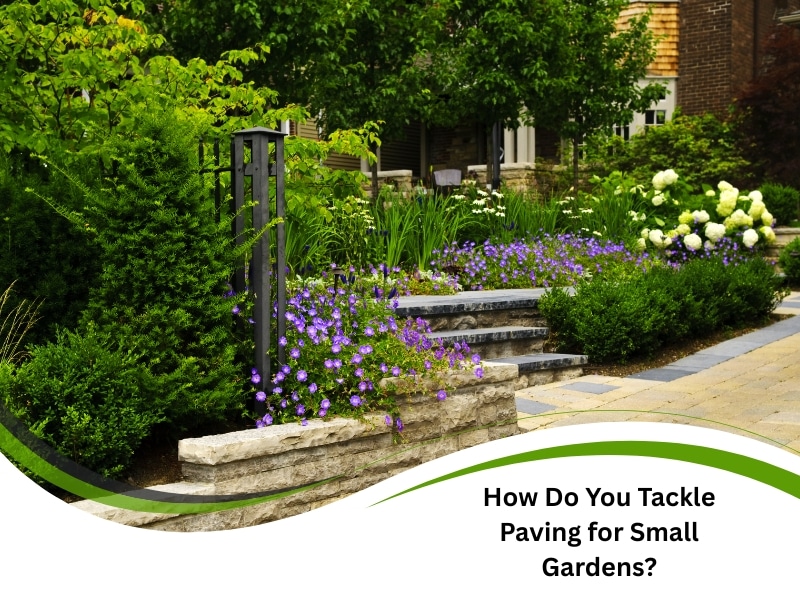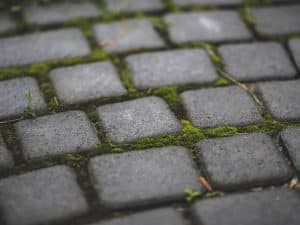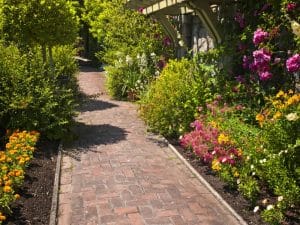Designing paving for small gardens demands a sharper eye for detail than larger spaces. The compact layout means every decision, material, placement, and pattern carries more weight. Small mistakes can have a significant impact on both function and aesthetics. Whether you’re trying to create visual flow or maximise space, proper planning is critical. This article explores how to navigate common issues and highlights the most effective strategies for compact garden paving.
What are the main challenges of paving for small gardens?
Small gardens present unique challenges that larger spaces often avoid. With limited area, every centimetre must serve a purpose, and poor decisions are harder to hide or fix later.
When you miscalculate in a tiny garden, it shows immediately. Common challenges include:
- Limited manoeuvrability during installation, which increases labour costs and complexity, especially when working around tight corners, trees, or fences
- Overcrowding from oversized materials or patterns, which makes the space feel cramped and disrupts natural sightlines
- Drainage issues, often caused when paving disrupts natural water flow, potentially leading to puddling or erosion
- Restricted design flexibility, requiring smarter use of space, multifunctional elements, and careful proportioning
Recognising these issues early helps prevent costly backtracking. You’ll want to plan like a chess player—two steps ahead of every move.
Why do poor paving choices affect garden functionality?
Functionality isn’t just about how a garden looks—it’s about how it works. Choosing the wrong paving material can affect access, safety, and comfort. You’ll feel the consequences every time you step outside. Poor paving choices often result in:
-
Slippery or uneven surfaces, which become hazardous during wet seasons, especially in shaded or moss-prone areas
-
Blocked flow or access routes, making movement awkward around furniture or garden beds
-
Lack of integration with furniture or features, leaving some zones underused or inaccessible
-
Inadequate edge support, which causes pavers to shift over time, creating tripping hazards
You want your garden to work as well as it looks. That balance begins with smart, fit-for-purpose paving choices that align with how you use your space.
How can improper design ruin small garden aesthetics?
It’s not just about function—design flaws show up loud and clear in a compact setting. Misjudged paving can throw off the whole look, making a garden appear cluttered or haphazard.
- Poor symmetry can break visual balance in already limited space
- Random or mismatched paver shapes create visual noise
- Unplanned transitions between paved and planted areas feel awkward
- Unconsidered edge treatments make the space feel unfinished
Instead of blending into the garden’s rhythm, bad paving draws the eye for all the wrong reasons. Before you commit, sketch your layout and assess how materials and shapes interact.
Here’s a helpful reference chart showing typical paver shapes and their visual impact in small spaces:
Paver Type | Best Use Case | Visual Impact | Maintenance |
Clay bricks | Classic pathways, borders | Warm, rustic feel | Low |
Concrete pavers | Patios, open seating zones | Neutral & durable | Medium |
Natural stone | Feature zones, premium finishes | High-end appearance | Medium-High |
Gravel | Informal paths, drainage support | Relaxed & earthy | Low |
What paving options work best for compact outdoor areas?
When space is limited, your paving choices should add both utility and style without overwhelming the garden. It’s all about scale, texture, and integration.
- Modular pavers offer clean lines and are easier to install accurately in tight spaces.
- Permeable pavers improve drainage and prevent water runoff issues
- Natural stone blends effortlessly with greenery and suits earthy aesthetics
- Lighter colours help open up the space visually
Texture plays a role too—smooth surfaces offer a modern finish, while rougher ones add contrast and grip. For layout direction, you might find creative paving ideas for small garden spaces especially useful when selecting materials that do more with less.
Can creative patterns enhance the appearance of small garden paving?
Absolutely. When chosen thoughtfully, paving patterns can significantly alter the feel of a small space. The trick is selecting a layout that visually stretches the area or draws attention to focal features.
- Herringbone, which adds texture and a touch of sophistication. It creates a sense of movement and works well in both modern and traditional spaces.
- A stretcher bond is a classic layout where pavers are laid in a staggered pattern. It helps create long lines and subtly widens narrow walkways.
- Circular or fan patterns are ideal for centrepieces or creating a courtyard effect. These lend a formal elegance and provide visual anchors.
- Randomised modular, which breaks the monotony of grids while hiding minor irregularities in surface level or alignment.
Of course, any pattern must still serve a function. A clever layout is worthless if it results in uneven surfaces or confusing traffic flow. That’s why you should first consider preparing the ground effectively before paving your garden to avoid settling or shifting down the track.
Is paving for small gardens worth the investment?
Some people assume paving isn’t necessary in a small garden, but that overlooks the daily usability and visual harmony it adds. Good paving enhances liveability, manages water, and grounds the whole outdoor layout.
- Durable paving reduces garden upkeep in high-traffic areas
- Defined edges and paths protect plantings and garden zones
- Professional paving adds long-term property value
- Aesthetic paving increases visual cohesion with indoor spaces
When done right, paving becomes a quiet backbone for your garden’s style and structure. If you’re unsure where to start, you can always discover expert solutions in paving for small gardens from professionals who work with compact outdoor spaces every day.
What’s the best way to maintain paving in small gardens?
Once your paving is installed, ongoing maintenance is minimal, but consistency is key. Small areas show wear more quickly, so it’s beneficial to incorporate simple maintenance into your routine.
- Sweep regularly to avoid staining from organic debris
- Treat joints with weed inhibitors to prevent cracks and movement
- Seal porous surfaces annually to extend their lifespan
- Check for settling or movement after heavy rain
Long-term durability isn’t just about the materials—it’s about how well they’re maintained. For eco-conscious households, it’s also worth reviewing guidelines for sustainable landscaping and paving practices to make choices that are both practical and planet-friendly.
Final thoughts
Paving for small gardens. It isn’t just about ticking a box—it’s about creating a space that works for you year-round. Done right, it adds value, beauty, and purpose to every square metre.
If you’re weighing up options or need layout advice, it’s worth taking the time to get in touch with A1 Gardening & Landscaping Sydney for tailored solutions that suit your space.



